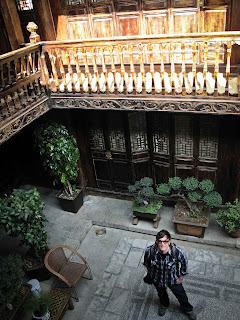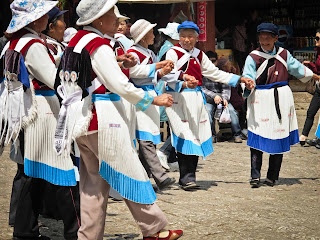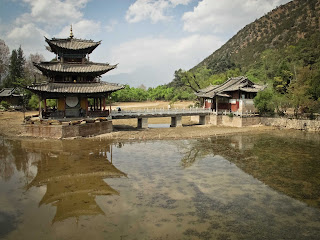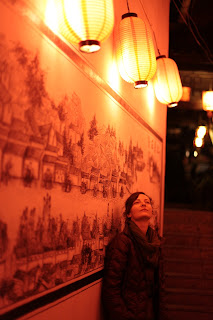Dramatically set in a valley with a stunning backdrop of Jade Dragon Snow Mountain, Lijiang's Old Town is a traffic-free maze of winding cobblestone alleys lined with wooden buildings and laced with canals, cafes and workshops of traditional craftsmen. Home to the Naxi minority, it has earned the title of the most pleasant urban scene in China we've experienced so far. Yes it's touristy, yes it's crowded (especially mid-day), but has plenty of charm, character and historic architecture to keep us wandering for days. The labyrinth of narrow streets and hidden pockets is wonderful to get lost in. And the air...what a relief for lungs and brains!.






After walking the center for an hour in search of a room, being offered a bed inside an oversized wooden chest while denied another in a lovely dirt cheap guest house because we're not Chinese ("No Chinese, no room."), we finally came across a place that took us in. It's highly possible the reason they let us stay was their inability to get rid of us in English - we barely got a hello from the receptionist. All the Chinese guests were giving us strange looks, vibes that had nothing to do with curiosity. From the moment we arrived in China, the 'cold shoulder' towards us as foreigners has frequently taken us by surprise, but nowhere has it been so blunt before. Sadly, decades of portraying westerners as villains now resurfaces in the form of distrust towards foreigners, particularly among the older generation. It definitely takes some determination to brush it aside as much as possible in order to appreciate other aspects of the unknown terrain and sustain a healthy perspective - one unaffected by generalizations and negative preconceptions.
UNESCO designated Old Town, however, is lovely. Dating back to the 13th century, the ancient town boasts with timber-framed structures detailed with elaborate ornamental carvings, architecture noteworthy stylistically for the absorption of elements of Han and Zang origin. Lijiang also possesses a complex water-supply system of great ingenuity that still functions effectively today. The town's layout, with it's intricate network of canals, provides a system for water and waste disposal configured in adherence to Feng Shui design principles. Historically, Lijiang was the center of silk embroidery in southwest China and the most important stop on the Ancient Silk Road.
architecturally, one of the most charming places we stayed in
tea doesn't get any more fresh than this...
no reason to quit while in China, breathing air is just as harmful
wedding crasher
The Naxi women were well known for their hand-made embroidery before the Cultural Revolution, during which most famous Naxi embroidery masters were imprisoned. Mao's quest to rid China of it's rich history left a trail of an extraordinary cultural devastation and it's effects are felt to this day. Human atrocities were accompanied by demolition of temples and historically significant structures throughout the country, acts of hatred and ignorance that profoundly affected collective consciousness and left permanent scars on the state of architectural heritage.
Naxi is a matriarchal society. With women in charge, responsibilities of men revolve around gardening and playing music (I can't help but chuckle).
Dancing and enjoying themselves during a mid-day performance on the square, these women emanated with affinity and comradery. Their affection for one another proved contagious as passerby joined hands and followed step in their hopping circle.
fatty but really good yak meat
Pavillion at Black Dragon Pool
.jpg)














.jpg)













































